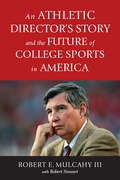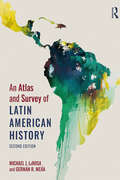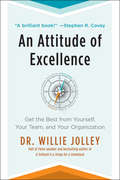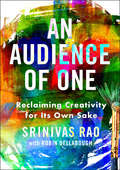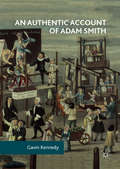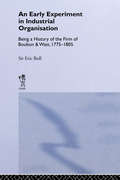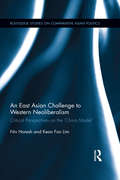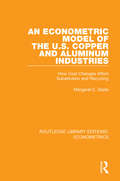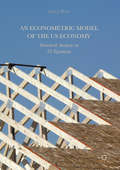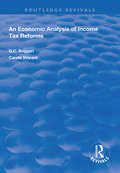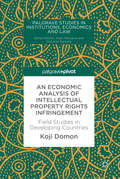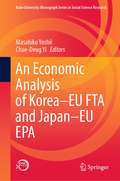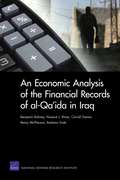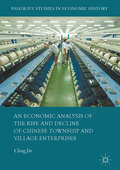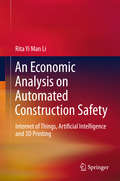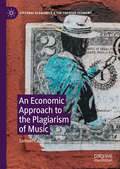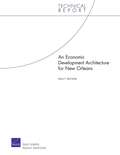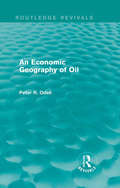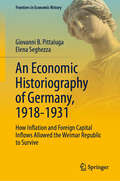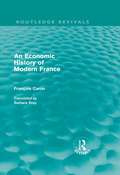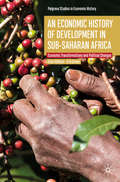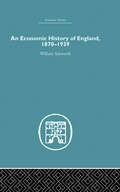- Table View
- List View
An Athletic Director’s Story and the Future of College Sports in America
by Robert E. MulcahyRobert Mulcahy’s chronicle of his decade leading Rutgers University athletics is an intriguing story about fulfilling a vision. The goal was to expand pride in intercollegiate athletics. Redirecting a program with clearer direction and strategic purpose brought encouraging results. Advocating for finer coaching and improved facilities, he and Rutgers achieved national honors in Division I sports. Unprecedented alumni interest and support for athletics swelled across the Rutgers community. His words and actions were prominent during a nationally-reported incident involving student athletes. When the Rutgers Women’s Basketball team players were slandered by racist remarks from a popular radio talk show host, Mulcahy met it head on. With the coach and players, he set an inspiring example for defending character and values. Though Mr. Mulcahy left Rutgers in 2009, his memoir reflects continued devotion to intercollegiate athletics and student athletes. His insights for addressing several leading issues confronting Division I sports today offer guidelines for present and future athletic directors to follow.
An Atlas and Survey of Latin American History
by Michael LaRosa German R. MejiaAn Atlas and Survey of Latin American History provides a comprehensive, accessible introduction to both the human and physical geography of Latin America and the social, cultural, political and economic events that have defined its history. Featuring 77 maps and accompanying text, the book provides topical overviews of the key developments and movements in Latin American history, ranging from the earliest human settlement to the present day. The fully updated second edition includes a new chapter on Latin America in the 21st century, featuring maps and essays on topics ranging from sports and telenovelas to the growth of the Latin American middle class and the rise and ebb of left-leaning political movements. Highly readable and beautifully designed, An Atlas and Survey of Latin American History 2e remains an engaging resource for students and others interested in Latin American history, politics, and culture.
An Attitude of Excellence: Get The Best From Yourself, Your Team, and Your Organization
by Dr. Willie JolleyYou imagine a "new and improved" version of yourself—one who has achieved your goals and reached your definition of success. But you stop at wanting to be better because you don't feel you have the tools to achieve it. You do have the power to make yourself into a winner. Success isn't a matter of chance—it's a matter of choice. It all comes down to your attitude and a mindset to pursue excellence. When you make the conscious choice to develop an attitude of excellence, you will achieve more, enjoy more, have better relationships, take better care of yourself physically and mentally, and vastly improve the quality of your day-to-day life. Armed with a positive attitude and the determination to pursue excellence, plus a coach to help you stay focused, you will become the best version of yourself. Dr. Willie Jolley is a world-renowned speaker and motivational coach. He is the expert Ford Motor Company turned to while on the brink of bankruptcy, and he helped the company go on to reject a government bailout and to reach billion-dollar profits. In this powerful new book, An Attitude of Excellence: Get the Best from Yourself, Your Team, and Your Organization, he teaches readers how to achieve more in their lives—both professionally and personally. Dr. Jolley's work has inspired millions with a simple message: The best way to grow your future is to grow yourself, and the best way to grow an organization is to grow the people in that organization. Why? Because great people will give great service, while negative people will kill your future. This eye-opening book features T.I.P.S. (Tips, Ideas, Principles & Strategies) everyone can use to enhance the quality of our relationships and our lives, both at work and at home, using the power of an attitude of excellence.
An Audience of One: Reclaiming Creativity for Its Own Sake
by Srinivas RaoThe creator of the Unmistakable Creative podcast makes a counterintuitive argument: By focusing your creative work on pleasing yourself, you can increase your productivity, happiness, and (eventually, paradoxically) the size of your audience.Creating for your own pleasure--whether you're writing a novel, composing songs, or painting a landscape--can seem pointless. It's tempting to focus on pursuing money and fame, rather than the process itself. But as Srini Rao warns, creating then turns into a chore that can harm your self-esteem and suck the pleasure out of life, rather than being a source of joy.Rao, host of the podcast The Unmistakable Creative, argues that we should counter this thinking by intentionally creating art for ourselves alone--an audience of one. In this book he shares the fascinating true stories of creatives who took this path, along with actionable tips and the research of creativity experts. You'll learn, for example: * How Oprah's intentional focus on her own work rather than the opinions of everyone else catapulted her into one of the most popular talk shows of all time. * How being process-driven can not only help you produce more work, but can make you happier outside of your creative time. * How to put together a creative "team of rivals" whose feedback can help you hone your craft and filter out useless feedback.By playing to an audience of one, we can find more happiness, increased productivity, and a greater sense of community.
An Australian Ballot for California?
by David A. Moss Dean Grodzins Marc CampasanoIn early 1891, California lawmakers were considering a plan to reform the state's elections through the introduction of an "Australian" ballot. Under this new system, candidates from all qualifying parties would appear on official ballots, which would be printed by county and municipal governments and which voters would ultimately fill out in secret. This would mark a substantial departure from the existing way in which votes were cast in California, or for that matter in most of the United States. Traditionally, political groups prepared and distributed party-line ballots, called "tickets," for voters to submit at the polls. Because each party ticket was visually distinctive (in most cases, distinguished by a particular color), it was easy for observers to determine how individual citizens had voted as they handed in their ballots. Closely monitoring the ballot boxes, representatives of the party "political machines" frequently paid supporters who voted for the machine ticket and sought to punish those who did not. Supporters of the Australian ballot promised it would end these abuses, bring greater secrecy and honesty to California's elections, and loosen the grip of party machines on the state and municipal governments. Despite some opposition in Republican circles, the Republican-dominated Assembly and Senate both passed the ballot bill by large margins in early March and sent it on to the Republican governor, Henry Markham, for his signature. If Markham signed the bill into law, California would join a growing roster of U.S. states using the new, secret ballot, and reformers would claim another victory in their battle against political machines.
An Authentic Account of Adam Smith
by Gavin KennedyThis book is a textual criticism of modern ideas about the work of Adam Smith that offers a new perspective on many of his famous contributions to economic thought. Adam Smith is often hailed as a leading figure in the development of economic theories, but modern presentations of his works do not reflect Smith's actual ideas or influence during his lifetime. Gavin Kennedy believes that Smith's name and legacy were often appropriated or made into myths in the 19th and 20th centuries, with many misconceptions persisting today. Offering new analysis of works on rhetoric, moral sentiments, jurisprudence, the invisible hand, The Wealth of Nations, and Smith's very private views on religion, the book gives a new perspective on this important canonical thinker
An Early Experiment in Industrial Organization: History of the Firm of Boulton and Watt 1775-1805 (Reprints Of Economic Classics Ser.)
by Eric RollFirst Published in 1968. Routledge is an imprint of Taylor & Francis, an informa company.
An East Asian Challenge to Western Neoliberalism: Critical Perspectives on the ‘China Model’ (Routledge Studies on Comparative Asian Politics)
by Niv Horesh Kean Fan LimAnalysts generally agree that, in the long term, the biggest challenge to American hegemony is not military, but rather China’s economic rise. This perception is spread in no small measure because Xi Jinping has – in the face of patent military inferiority – conducted himself much more boldly on the world stage than Hu Jintao. Meanwhile, China has also begun conjuring up an alternative vision for global leadership, now widely termed as the ‘China model’. This book therefore offers a critical and comprehensive explanation of the China model and its origins. Using a range of case studies, covering varying historical and geographical approaches, it debates whether the Chinese experience in the last three decades of economic reform should be interpreted as an answer to the reigning hegemony of neoliberalism, or rather a further reinforcement of it. To answer these questions, it provides an investigation into what China may have learned from its East Asian neighbours’ earlier economic successes. It also examines how it is responding to and might even reconfigure the world political-economic system as it develops fresh and potentially more powerful regulatory capacities. Providing a multi-dimensional analysis of the ‘China model’, the book will be of interest to students and scholars of Chinese Economics, Economic Geography and Chinese Studies.
An Econometric Model of the U.S. Copper and Aluminum Industries: How Cost Changes Affect Substitution and Recycling (Routledge Library Editions: Econometrics #17)
by Margaret E. SladeOriginally published in 1984. This book addresses the economics of the changing mineral industry, which is highly affected by energy economics. The study estimates, in quantitative terms, the short- to mid-term consequences of rising energy prices alongside falling ore quality for the copper and aluminum industries. The effects of changing cost factors on substitution between metals is assessed as is the potential for relying on increased recycling. Copper and aluminum industry problems should be representative of those faced by the mineral processing sector as a whole. Two complex econometric models presented here produce forecasts for the industries and the book discusses and reviews other econometric commodity models.
An Econometric Model of the US Economy: Structural Analysis in 56 Equations
by John J. HeimThis book explores the US economy from 1960 to 2010 using a more Keynsian, Cowles model approach, which the author argues has substantial advantages over the vector autoregression (VAR) and dynamic stochastic general equilibrium (DSGE) models used almost exclusively today. Heim presents a robust argument in favor of the Cowles model as an answer to the pressing, unresolved methodological question of how to accurately model the macroeconomy so that policymakers can reliably use these models to assist their decision making. Thirty-eight behavioral equations, describing determinants of variables such as consumption, taxes, and government spending, are connected by eighteen identities to construct a comprehensive model of the real US economy that Heim then tests across four different time periods to ensure that results are consistent. This comprehensive demonstration of the value of a long-ignored model provides overwhelming evidence that the more Keynesian (Cowles) structural models outperform VAR and DSGE, and therefore should be the models of choice in future macroeconomic studies.
An Economic Analysis of Income Tax Reforms (Routledge Revivals)
by G.C Ruggeri Carole VincentFirst published in 1998, Ruggeri and Vincent analyse different tax reform proposals to create a discourse on dispelling the myths surrounding the flat tax. This book proposes a progressive and comprehensive tax reforms, whilst simplifying the tax system for the vast majority of tax payers. Whilst ensuring the tax system reforms dose not hinder economic growth. This book should be required reading for anyone interested in the problems and promise of tax reform.
An Economic Analysis of Intellectual Property Rights Infringement: Field Studies in Developing Countries (Palgrave Studies in Institutions, Economics and Law)
by Koji DomonUsing unique field research from across Asia, this book examines the real markets of illicit products that breach intellectual property rights (IPR). The text presents three case studies regarding IPR infringements: unauthorised music content; fake spare parts of motorcycles; and fake Japanese food. Each study has unique characteristics, though their general concepts and problems have similar roots. The book shows what is happening in the black market and systems of illicit trade, providing information for stakeholders in Intellectual Property Rights to consider in devising effective methods for minimizing profits lost to copied and fake products.
An Economic Analysis of Korea–EU FTA and Japan–EU EPA (Kobe University Monograph Series in Social Science Research)
by Masahiko Yoshii Chae-Deug YiThis monograph compares two trade agreements among three important economic regions, namely, the Korea–EU free trade agree (FTA) and the Japan–EU Economic Partnership Agreement (EPA). The two new types of agreements came into effect in the 2010s. They not only create more favorable trade and economic conditions in these regions but also produce spillover effects to bring about more comprehensive conditions in other area. First, the quantitative research for both agreements using the CGE model and a tentative analysis of the Japan–EU EPA in the analysis show that both have already created positive impacts on all three economies by lifting or reducing tariff and non-tariff barriers. Such positive impacts are also expected to be felt by SMEs in these countries that are involved. Additionally, the high level of tariff and non-tariff liberalization in the two current agreements will make positive impacts on the negotiation of other FTAs and on WTO reform. The advantages of the FTA and EPA dealt with in this book are not restricted to these economic effects. As the agreements are comprehensive, they will create more favorable social conditions not only in these economic regions but in other areas of Asia as well.
An Economic Analysis of the Financial Records of al-Qa'ida in Iraq
by Benjamin Bahney Carroll Ganier Barbara Sude Renny Mcpherson Howard J. ShatzThis monograph analyzes the finances of the militant group al-Qa'ida in Iraq in Anbar province during 2005 and 2006, at the peak of the group's power and influence. The authors draw on captured financial documents that give details on the daily financial transactions of one specific sector within Anbar province and of the financial transactions of the AQI provincial administration.
An Economic Analysis of the Rise and Decline of Chinese Township and Village Enterprises (Palgrave Studies in Economic History)
by Cheng JinThis book provides a historical economic analysis of two key issues relating to township and village enterprise (TVE) development in China. Firstly, the nature of the evolving relationship between TVEs and local government; in particular how TVE entrepreneurs have used institutionalized power to secure the political influence needed to defend their financial independence. Secondly, the relationship between TVEs and state-owned enterprises (SOEs), and the role of SOEs in China's economic transition. This study highlights the importance of the role of SOEs in the "dual-track pricing system" and its impact on other parts of the economy. Township and village enterprises were key to China's success in the late twentieth century, but have more or less disappeared as an entity over the past decade or so. By measuring the structural difference of the SOE sector before and after 1998-2003 SOE reform, Jin explains their fast catch-up in productivity since the mid-1990s, as well as the relative decline of TVE productivity.
An Economic Analysis on Automated Construction Safety
by Rita Yi LiThis book addresses information technologies recently applied in the field of construction safety. Combining case studies, literature reviews and interviews to study the issue, it presents cutting-edge applications of various information technologies (ITs) in construction in different parts of the world, together with a wealth of figures, tables and examples. Though primarily intended for researchers and experts in the field, the book will also benefit graduate students.
An Economic Approach to the Plagiarism of Music (Cultural Economics & the Creative Economy)
by Samuel CameronThis book is an economic analysis of plagiarism in music, focusing on social efficiency and questions of inequity in the revenue of authors/artists. The organisation into central chapters on the traditional literary aspect of composition and the technocratic problem of ‘sampling’ will help clarify disputes about social efficiency and equity. It will also be extremely helpful as an expository method where the text is used in courses on the music business.These issues have been explored to a great extent in other areas of musical content—notably piracy, copying and streaming. Therefore it is extremely helpful to exclude consumer use of musical content from the discussion to focus solely on the production side. This book also looks at the policy options in terms of the welfare economics of policy analysis.
An Economic Development Architecture for New Orleans
by Kevin F. MccarthyIn response to the current situation in New Orleans in the aftermath of Hurricane Katrina, this report provides recommendations regarding effective organizational and strategic approaches to revitalizing the city's economy, identifies the best practices that other cities have used to foster economic development, describes how these practices might be applied to New Orleans, and considers historical trends and past development missteps.
An Economic Geography of Oil (Routledge Revivals)
by Peter R. OdellAn Economic Geography of Oil, first published in 1963, analyses the reasons behind the spatial distribution of the different sectors of the world oil industry. In the first part of the book, Peter Odell examines the pattern of the world supply of oil, showing the important changes that took place between 1945 and the early 1960s and highlighting the physical, economic, political and organizational factors which contributed to these developments. In the second part, Odell analyses the relationship between oil and other sources of energy, together with the more fundamental relationship between energy consumption in different areas of the world, and economic development. Finally, attention is paid to those aspects of the industry which are concerned with getting the oil from the point of production to that of consumption; the refining industry, transportation requirements and local distribution patterns are studied. These strands are drawn together in a relevant and interesting conclusion, which considers the overall impact of the oil industry on economic and industrial development.
An Economic Historiography of Germany, 1918-1931: How Inflation and Foreign Capital Inflows Allowed the Weimar Republic to Survive (Frontiers in Economic History)
by Elena Seghezza Giovanni B. PittalugaContrary to existing economic analyses of the Weimar Republic, this book looks beyond the explanations of the individual events that characterized it - in particular hyperinflation, Brüning's fiscal policy, and the 1931 crisis. Instead, it adopts a more unified approach, and thereby sheds light on the underlying causes of these events. The book argues that these individual events were the final result of economic processes and policy choices which had made it possible to mitigate the social and political conflict that would otherwise have undermined the Republic’s existence. Specifically, it postulates that hyperinflation was the result of the "persistent" inflation, which had permitted Germany to maintain low unemployment, meet unions' wage demands, and contain left-wing radicalism. Similarly, the banking and currency crisis of 1931 was caused by a sudden stop related to the high level of foreign debt incurred by Germany after the Dawes Plan. Debt which had, however, enabled the country to finance the persistent external deficits resulting from its high domestic demand and large public expenditure incurred in an attempt to avoid social conflict. The book reviews the various models and approaches proposed highlighting their relative strengths and weakness and concludes by providing a unifying common thread which explains how the dramatic economic events which characterized the Weimar Republic were the result of the very economic processes which had contributed to its temporary survival. This book will appeal to students, scholars, economic researchers in general, and more specifically to those interested in economic history, monetary and financial economics, economic policy, political decision making, and political economy, in particular, those seeking a better understanding of the Weimar Republic's economic history.
An Economic History of Modern France (Routledge Revivals)
by Francois CaronFirst published in 1979, this richly documented study of French development from the early nineteenth century to the present day is of particular importance to students both of history and economics. Francis Caron moves as confidently through the fields of current economic policy and modern economics as he does through the traditional subject matter of French nineteenth-century economic history. His book incorporates the mass of research that has appeared in monograph and periodical form in recent years, making it accessible for the first time to the English-speaking reader.
An Economic History of British Steam Engines, 1774-1870: A Study on Technological Diffusion (Contributions to Economics)
by Haris KitsikopoulosThis book traces the diffusion trajectory of the second and third generation of British steam engines, the Watt and high-pressure models, covering the period 1774 to 1870. It begins by subjecting to econometric analysis the latest version of Dr. Kanefsky's database on 18th century steam engines coming up with an upward revision of the total amount of horsepower installed by 1800. Subsequent chapters delve into the determinants of the diffusion process through the third quarter of the 19th century relating to engines used both in mining and industry as well as transportation (railways, steam cars). The book's main contribution to the literature lies in drawing material from a very large volume of 18th- and 19th-century sources found in the Dibner Library of Rare Books, Smithsonian, and by utilizing a fair amount of technical literature pertaining to the economic factors driving the diffusion process. This great expansion of the empirical material has led to bringing multiple revisions to the work of other authors on the key aspects and determinants of the diffusion process. In conjunction with the publication by the author of an earlier monograph on the first generation of steam engines, the Newcomen model, the present study completes the task of offering the most comprehensive account of the preeminent and most strategic technology of the British Industrial Revolution. This book will appeal to students, scholars, and researchers of economic history and history of technology, interested in a better understanding of the industrial revolution in general and the role of British steam engines in particular.
An Economic History of Development in sub-Saharan Africa: Economic Transformations and Political Changes (Palgrave Studies in Economic History)
by Ellen Hillbom Erik Green‘This is a desperately needed book. It not only surveys the field of African economic history at the level of undergraduate students, but provides several fresh perspectives, drawing on insights from the latest research on the evolution of African societies and their economic prosperity. This valuable source of teaching material will be the premier text on African economic history for at least the next decade.’—Johan Fourie, Stellenbosch University, South Africa This upper level textbook offers a historical understanding of sub-Saharan Africa. By looking at the economic history of the African region from before the arrival of European territorial control all the way through to Africa’s integration in the current era of globalisation, readers can understand the development paths for African countries today. Organisation of production, social structures, trade, and governance are key factors in the discussion about African success stories and failures. Suitable reading for upper level undergraduates, MSc and postgraduate students, in addition to policy makers and development practitioners looking for a comprehensive overview of Africa from an economic and social perspective. Hillbom and Green also provide a starting point for the study of African economic history for those who would like to continue their own research in this area.
An Economic History of Early Modern India
by Tirthankar RoyThe death of the Mughal emperor Aurangzeb in 1707 until the annexation of Maratha territories by the British East India Company in 1818 was a period of transition for the economy of India. This book focuses on these transitions, and shows how a study of this period of Indian history contributes to a deeper understanding of the long-run patterns of economic change in India. Momentous changes occurred in business and politics in India during the eighteenth century - the expansion of trade with Europe and the collapse of the Mughal Empire, resulting in the formation of a number of independent states. This book analyses how these two forces were interrelated, and how they went on to change livelihoods and material wellbeing in the region. Using detailed studies of markets, institutions, rural and urban livelihoods, and the standard of living, it develops a new perspective on the history of eighteenth century India, one that places business at the centre, rather than the transition to colonial rule. This book is the first systematic account of the economic history of early modern India, and an essential reference for students and scholars of Economics and South Asian History.
An Economic History of England 1870-1939
by William AshworthThis is a comprehensive account of a decisive epoch in England's economic development by a leading economic historian. 'Works of economic history often get bogged dwon in figures - so many machines, so much unemployment, often, too, they are histories of technology, not of economic organization. Professor Ashworth goes to the opposite extreme in a most praiseworthy way: his book is actually good to read. Though there are tables of statistics (eleven of them), the book is an essay in interpretation, not an encyclopedia; it enriches our understanding rather than adding to our knowledge.' A.J.P. Taylor. This classic book was first published in 1960.
